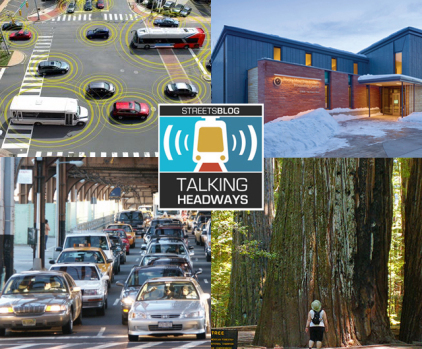This week we’re joined by Zabe Bent, director of design for the National Association of City Transportation Officials. We chat about how we think too much about the future and growth, the MUTCD process, and how she would start the design an infrastructure bill.
For those of you who prefer to read rather than to listen, check out an edited transcript below the audio player. For the unedited full podcast, click here.
Jeff Wood: Science fiction is something that you're interested in. I'm wondering if there's any kind of parallels between what futurists talk about and what we're seeing in the built environment, the current time period?
Zabe Bent: You're going to get me in trouble ... because I am not a futurist. Even though I am currently writing a novel that centers time travel as the device, I think a lot of our urban planning perspectives focus on what's going to happen in the future. It forces us to think about growth and change. I think that inherently means that we're going to focus ourselves on not what is happening now. Also, when we think about growth, it's often in terms of either the outlier or the sort of the biggest grower, you know, the biggest change, which really doesn't allow us to focus on what's happening to the everyday person or what's happening to the marginalized group or what have you.
So, I spend a lot of time, especially recently, trying to say, please, for the love of God, demand is important, so that we understand what is happening and can describe it. I want to focus on need. That means that we're focusing on what's happening now, just as much as the future, but a lot of our planning processes focus on trends and growth and where we're going to, and I'm like, please solve at least one problem that's happening now. Just try; let's do that.
Jeff Wood: You always see those models. I think recently a number of different outlets have posted this as a commentary on the model, but, you know, there's always this undulating travel model or, you know, transportation, VMT or whatever it is. Then all of the models just say, they're all straight up in the air. Like it's going to just go up, up and up forever. Then I think the pandemic maybe changed our mindset for two seconds. Then everybody went back to growth. Again, it seems like maybe we didn't learn something that we should have learned from this last year in terms of the transportation and growth.
Zabe Bent: Yeah, I think that's true in a lot of ways. I think part of it is our desire to re-embrace some level of comfort. For some reason that means normal. I personally don't find normal or getting back to normal as a comforting thing because normal wasn't working in a lot of different ways for a lot of different people. But I also think that we've changed a lot of things about the way that we do projects during the pandemic. I think the cities that are really going to do well now are cities that are also looking at their systems and our modeling system. I was just at a modeling conference where a lot of people were talking about how models need to change in order to be accepted; models need to change or evolve in order for people to understand how to use them better.
But also we need to change. We build models, we build the algorithms that go into them. So, we also need to change our thinking about what are the systems that we're using to predict what's happening. That takes a lot more time and I'm trying to be patient about that, but it's also incredibly frustrating when we see that this is not working. I also think that the modelers that are doing interesting things are looking at how to use models, not just to answer questions of what will happen in the future, but also to simply change the way that we do analysis about our transportation numbers.
Jeff Wood: What does some of that look like? What would that look like? If we were to change kind of the way we thought about models, generally?
Zabe Bent: Looking at how models help us look at geospatial data, again, not just future, but how to compare different scenarios and how we change different inputs. Some of that is certainly about the future and understanding growth and trends and where they're happening. But I think a lot of the scenario analysis could happen now. What if we change the policy, which could be a today type of thing, or a need-based thing, or what if we understood how people use the network of the system differently based on some outcomes and outputs? So, I think those are some really interesting analysis, and there are few cities that are doing really interesting work on that front.
Again, I'm using the model more as an analysis tool rather than simply a forecasting tool.






